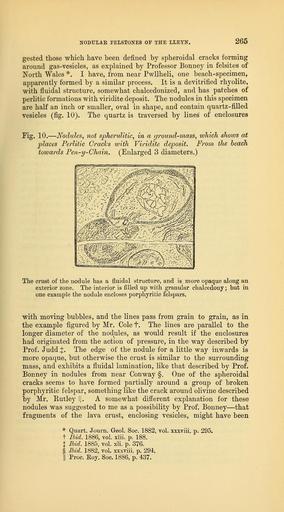MAKE A MEME
View Large Image

| View Original: | The_Quarterly_journal_of_the_Geological_Society_of_London_(13937158391).jpg (1166x2104) | |||
| Download: | Original | Medium | Small | Thumb |
| Courtesy of: | commons.wikimedia.org | More Like This | ||
| Keywords: The Quarterly journal of the Geological Society of London (13937158391).jpg NODULAR EELSTONES OF THE LLEYN 267 <br> lithologically a marked resemblance and contains similar nodular <br> structures <br> II By their texture the rocks must he classed as petrosiliceous <br> and they illustrate in a marked manner many structures which are <br> probably due to secondary devitrification They break with sub- <br> conch oidal fracture ; slides from them exhibit various micrographic <br> and dendritic growths and the ground-mass may be formed of <br> spherulites interlocking with irregular outlines Other sphe- <br> rulitic formation occurs on a large scale in the pyromerides and in the <br> radial crust of agate-nodules Felspar crystals may be modified by <br> micrographic structure and are sometimes silicified and chalcedony <br> or quartz is found filling veins the interior of nodules and the hollows <br> of vesicular lavas Thus the rocks exhibit much evidence of a sili- <br> cification and often of a radialization possibly connected with it f <br> and we may imagine that the lessening activity of the volcanoes <br> manifested itself in the percolation of heated waters carrying silica <br> in solution Geysers may have been in eruption near this locality ; <br> and some of the Ordovician conditions of the Lleyn may have been <br> similar to the Miocene activity of Schemnitz or to modern pheno- <br> mena in Iceland Possibly some of the marked perlitic and similar <br> structures were originated or intensified during the secondary alter- <br> nations of temperature in this Solfatara-stage of the district <br> III The nodular structures seem capable of being classed in the <br> following groups ” <br> 1 Contraction-spheroids or magnified perlitic structures <br> 2 Masses resulting from flow-brecciation <br> 3 Solid spherulites or pyromerides <br> 4 Agate-nodules with an outer spherulitic crust <br> 5 Quartzose amygdaloids <br> 6 Spheroidal formations developed around a nucleus such as <br> an agate-nodule a group of crystals or an original vesicle of <br> the lava <br> The large spherulites where their relations are evident seem <br> developed either along certain strata or within masses of flow- <br> brecciation Generally neighbouring examples show some approxi- <br> mation to a uniformity in their size They stand out by weathering <br> of the mass as is very noticeable in the Jersey rock where Prof <br> Bonney stated that so far as he could see they were well defined <br> only on an exposed surface and were scarcely traceable on a fresh <br> fracture They appear also to be generally uninfluenced by the <br> pressure which has modified the matrix in certain Welsh localities <br> Thus the spherulite seems to be the most durable part of the rock <br> The mass of the rock very commonly exhibits an originally vesicular <br> character resembling that of a modern trachyte The matrix <br> surrounding the nodular spherulites consists for the most part of what <br> must have been a compact laminated glassy lava now de vitrified <br> Pres Addr Geol Soc Prof Bonney 1885 pp 68 69 <br> t Compare Delesse Bull Soc GeoJ de Fr 1852 2 e ser t ix p 175 36940060 113696 51125 Page 265 Text 45 http //www biodiversitylibrary org/page/36940060 1889 Geological Society of London Biodiversity Heritage Library The Quarterly journal of the Geological Society of London v 45 1889 Geology Periodicals Smithsonian Libraries bhl page 36940060 dc identifier http //biodiversitylibrary org/page/36940060 smithsonian libraries Information field Flickr posted date ISOdate 2014-04-21 Check categories 2015 August 26 CC-BY-2 0 BioDivLibrary https //flickr com/photos/61021753 N02/13937158391 2015-08-26 05 50 43 cc-by-2 0 PD-old-70-1923 The Quarterly journal of the Geological Society of London 1889 Photos uploaded from Flickr by Fæ using a script | ||||